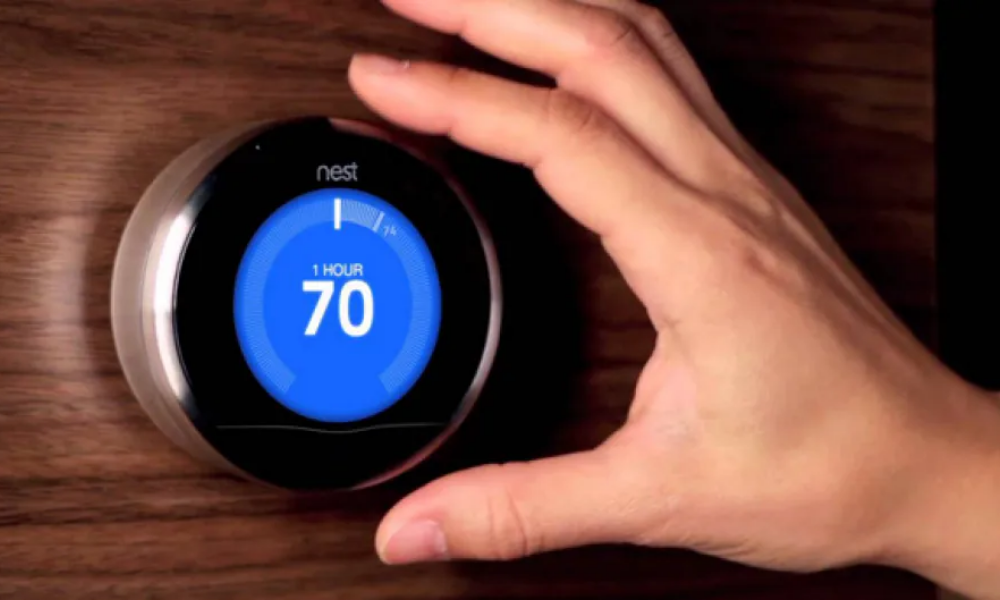It’s no secret that heating and cooling your home can be expensive, but did you know that a smart thermostat could help you save money on your energy bill? Have you considered purchasing a smart thermostat? But you’re undecided about switching. Innovative technology adds unique features to your house, but it may also help you save energy and money. According to the EPA, adopting a programmable thermostat can save you around $180 each year. It’s even easier with a smart thermostat that takes care of everything.
What Is a Smart Thermostat?
A smart thermostat is a type of thermostat that can be programmed to adjust the temperature in a home or office based on a set schedule or according to the conditions outside. Smart thermostats can also be controlled remotely using a smartphone or computer. Some models even include sensors that can detect whether someone is in the room and adjust the temperature accordingly. Smart thermostats can save energy by automatically lowering the temperature when no one is home or raising it when someone arrives. They can also help reduce greenhouse gas emissions by making it easier to conserve energy.
What Are the Benefits of a Smart Thermostat?
There are several benefits to using a smart thermostat, including:
- They pick up on your habits.- This is why smart thermostats are so helpful. You program your optimum temps and settings at first, and the thermostat will then learn when you come and go and what temperatures you prefer at different times of the day over time by observing your behavior. When you return home, your system may automatically alter your settings to ensure that your home is at the ideal temperature. Some thermostats even alter the temperature based on the humidity level.
- They keep track of your activities. Smart thermostats with two-way communication constantly monitor your usage, collect data, and share it. Their remote interfaces can even estimate your bills and show you how much energy you’re using. You can either make manual changes to your program or allow your thermostat to do it for you. The data is where the magic happens. The more information you have, the easier it will be to adjust your temperatures and see how they affect your energy bill. Smart thermostats provide you with the data you need to make informed decisions about how to save energy and money.
- While you’re away, they put in a lot of effort.- When you’re not at home, most systems will automatically switch to an eco option, allowing you to save energy. The thermostat detects when someone is at home or when everyone has left, and there is no movement in the house using sensors. They may also use geo-tracking to determine when your phone is no longer within range of your home, signaling to your system that it is safe to switch to eco mode. You may turn off your system when you’re gone for an extended period, such as on vacation. Your innovative technology will only turn it on if temperatures become dangerously high or low, preventing problems such as frozen water pipes.
- They work with solar panels and smart grids.- Smart thermostats are perfect for those who have a home with solar panels. Solar energy collected during the daytime can be used to heat your home in the evening. When matched with a smart thermostat, this technology becomes even more efficient, as you can use the solar energy collected during the daytime to cool your home at night. Smart thermostats are also compatible with smart grids, allowing two-way communication between the grid and your thermostat, and it allows you to save even more energy and money.
How Can a Smart Thermostat Help you Save money?

Companies like Nest say that you can save up to 15% on cooling costs, and ecobee claims savings of 23%. However, these savings are primarily dependent on various circumstances, including the size of your home, the type of insulating materials used in its construction, your specific usage, and the sort of thermostat you’re replacing. Ecobee’s estimate compares Smart thermostats to a standard temperature hold, but Nest’s figures are based on users who have programmed their thermostats at least once.
On the internet, there’s some discussion about whether these devices can save enough energy to make a difference in your costs, especially when compared to programmable alternatives. Some users believe that smart thermostats save them money, while others claim that they are just fancy versions of programmed ones already on the market. As is often the case, the reality lies somewhere in the middle.
The problem is that programmable thermostats are a hassle to use, and they only function if your schedule is highly predictable and you keep track of them regularly. If you’re the type of person who makes a routine, sticks to it, and remembers to adjust your thermostat if you depart from it manually, a smart thermostat is unlikely to save you much money. (However, you may save some time and mental energy.) Smart thermostats like the Enbridge, Nest, ecobee, or Honeywell T9 have a few automation options that may save you money if you’ve programmed your thermostat but find it tedious enough that you rarely fiddle with it.
Tell It if you’re at Home or Not
Most smart thermostats can detect your presence and adjust the temperature to save electricity when you’re not at home. The Nest calls it “Home/Away Assist,” while ecobee calls it “Smart Home/Away.” This setting typically uses a combination of the thermostat’s internal motion sensor and the GPS in your phone to determine if you’re inside a specific perimeter—or, in other words, whether you’re at home or not. However, for it to work correctly, you’ll need to connect it to your phone and the phones of everyone living with you—otherwise, the thermostat may believe no one is home when only you are.
The more erratic your schedule is, the more beneficial this gets. My wife, for example, stays at home with our two little children, so we can’t simply set the thermostat off from 9 a.m. to 5 p.m. We can, however, configure it to switch off anytime she takes the kids out for the day, regardless of whether her phone is still on the premises. A programmable thermostat is significantly less beneficial if you arrive and go at odd times. Even if you only have irregular weekends, it’s a helpful feature that can save you money over time.
Separate Temperature Sensors Are Recommended
The majority of houses do not maintain a constant temperature throughout the construction. Our living room is always more relaxed than our office and bedrooms, which is inconvenient because we need to account for those spaces when adjusting the thermostat. Separate temperature sensors can be placed around the house with thermostats, such as the ecobee and Honeywell T9.
They can detect whether someone is in a particular space and change the temperature accordingly because they have occupancy sensors. So, the thermostat may cool things down a little more when I’m at work or when my son wants to play in his room rather than cooling the entire house to keep the warmest areas comfortable. And it won’t waste electricity cooling those sections when we’re all in the living room.
These sensors may also be used to heat and cool rooms on a timetable, so you can tell your thermostat to cool the living room to 75 degrees Fahrenheit during the day and the bedroom to 75 degrees Fahrenheit at night. On the other hand, the occupancy sensor is the more beneficial “smart” feature in this case, which is why I think Nest’s temperature sensors are a little too limiting. Still, it’s better than a typical programmable thermostat, so if you have a larger home, I’d recommend getting a few temperature sensors for the rooms you frequently use.
Create your Own Automation Rules from Scratch
The Nest, ecobee, and Honeywell applications have valuable automation capabilities, but they’re not the only ones you’ll receive with a small thermostat. You may develop simple “if this, then that” rules that combine a variety of other apps and services using a tool like IFTTT. Suppose your family, for example, has a habit of opening the windows regardless of the temperature (because they’re monsters). In that case, you can install a few sensors on the windows and use a smart home hub like Samsung SmartThings to enable IFTTT to turn off your thermostat anytime the windows are open. You won’t end up accidently chilling the entire neighborhood this way. (I’m speaking from personal experience.) You may not even need to acquire new equipment to make this work if you already have a security system that works with IFTTT.
It’s easy to see how this may become extremely strong. You may set ceiling fans to turn on at a given temperature threshold if connected to a smart switch, thereby saving you from putting on the air conditioning too early. IFTTT even works with a few energy companies, allowing you to automatically change your thermostat during peak usage times when prices rise.
Keep Track of your Energy Consumption Over Time
Smart thermostats can track your usage over time, offering detailed information on your energy consumption, graphs of your home’s temperature compared to the outside weather, etc. It’s easy to overlook these at first. Still, many users find that simply paying attention to these insights results in the most significant energy savings. You may discover that you’ve been using the air conditioning while the temperature outside was only a few degrees warmer or that your home/away setting was malfunctioning. Check in on these once a month, and you’ll get some suggestions on how to save a few more dollars.
Become a Participant in Energy-Saving Programs
The characteristics listed above partially depend on your schedule and the location of your home. Some people may realize minor savings from utilizing them, while others may see a significant improvement. However, regardless of how much energy you use, a smart thermostat may enable you to take advantage of energy-saving initiatives in your city that provide bill credits.
Remember to Take Advantage of Any Rebates that may be Available
There are several rebates and incentives available in Canada for installing a smart thermostat. You may be able to get a rebate from your energy company or even receive a tax credit. Rebates can often be as high as $100, so it’s worth looking into before purchasing.
Some rebates available on energy bills are BC Hydro’s SaveONenergy Home Thermostat Rebate Program, Toronto Hydro’s Smart thermostat rebate program, and Manitoba Hydro’s PowerSmart residential air conditioner rebates, and Nova Scotia Power’s Home Energy Conservation Programs.
Conclusion
Smart thermostats are a great way to save money on your monthly energy bill. They can also help you manage the temperature in your home more efficiently and reduce wasted heat or cooling, which is good for everyone’s wallet. But before you invest in one of these devices, it’s essential to understand what makes them different from standard thermostats and how they can benefit you.
Most smart thermostats allow you to control the temperature in your home remotely using a smartphone or computer. It means that you can make changes while away from home, saving energy and money in the process. Smart thermostats also learn your habits over time to automatically adjust the temperature based on your schedule, and it can help you save even more money on your energy bill.
If you’re looking for a way to reduce your monthly energy costs, a smart thermostat is great. They’re easy to use and can help you save money in the long run.
Read More: The Canada Greener Homes Grant








Leave a Reply